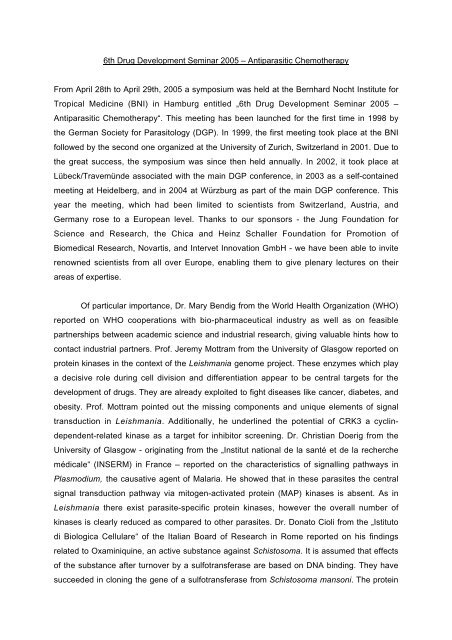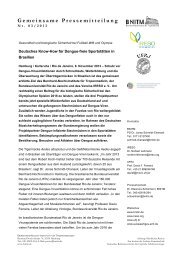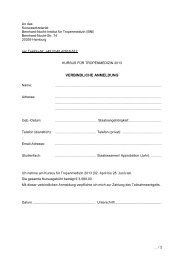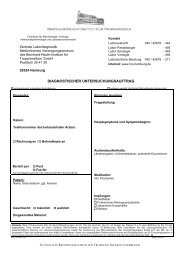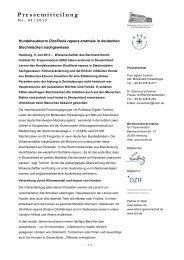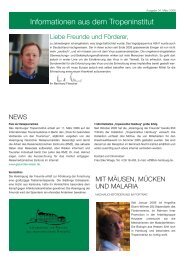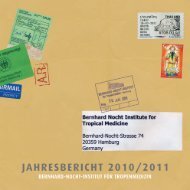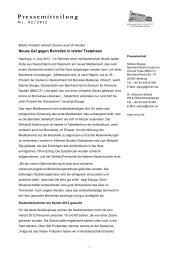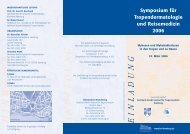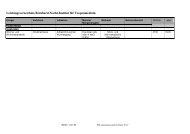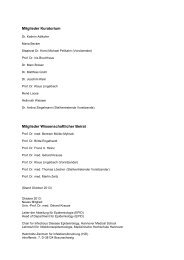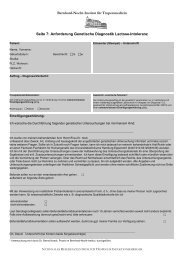Conference report (englisch/English) - Bernhard-Nocht-Institut für ...
Conference report (englisch/English) - Bernhard-Nocht-Institut für ...
Conference report (englisch/English) - Bernhard-Nocht-Institut für ...
You also want an ePaper? Increase the reach of your titles
YUMPU automatically turns print PDFs into web optimized ePapers that Google loves.
6th Drug Development Seminar 2005 – Antiparasitic ChemotherapyFrom April 28th to April 29th, 2005 a symposium was held at the <strong>Bernhard</strong> <strong>Nocht</strong> <strong>Institut</strong>e forTropical Medicine (BNI) in Hamburg entitled „6th Drug Development Seminar 2005 –Antiparasitic Chemotherapy“. This meeting has been launched for the first time in 1998 bythe German Society for Parasitology (DGP). In 1999, the first meeting took place at the BNIfollowed by the second one organized at the University of Zurich, Switzerland in 2001. Due tothe great success, the symposium was since then held annually. In 2002, it took place atLübeck/Travemünde associated with the main DGP conference, in 2003 as a self-containedmeeting at Heidelberg, and in 2004 at Würzburg as part of the main DGP conference. Thisyear the meeting, which had been limited to scientists from Switzerland, Austria, andGermany rose to a European level. Thanks to our sponsors - the Jung Foundation forScience and Research, the Chica and Heinz Schaller Foundation for Promotion ofBiomedical Research, Novartis, and Intervet Innovation GmbH - we have been able to inviterenowned scientists from all over Europe, enabling them to give plenary lectures on theirareas of expertise.Of particular importance, Dr. Mary Bendig from the World Health Organization (WHO)<strong>report</strong>ed on WHO cooperations with bio-pharmaceutical industry as well as on feasiblepartnerships between academic science and industrial research, giving valuable hints how tocontact industrial partners. Prof. Jeremy Mottram from the University of Glasgow <strong>report</strong>ed onprotein kinases in the context of the Leishmania genome project. These enzymes which playa decisive role during cell division and differentiation appear to be central targets for thedevelopment of drugs. They are already exploited to fight diseases like cancer, diabetes, andobesity. Prof. Mottram pointed out the missing components and unique elements of signaltransduction in Leishmania. Additionally, he underlined the potential of CRK3 a cyclindependent-relatedkinase as a target for inhibitor screening. Dr. Christian Doerig from theUniversity of Glasgow - originating from the „<strong>Institut</strong> national de la santé et de la recherchemédicale“ (INSERM) in France – <strong>report</strong>ed on the characteristics of signalling pathways inPlasmodium, the causative agent of Malaria. He showed that in these parasites the centralsignal transduction pathway via mitogen-activated protein (MAP) kinases is absent. As inLeishmania there exist parasite-specific protein kinases, however the overall number ofkinases is clearly reduced as compared to other parasites. Dr. Donato Cioli from the „Istitutodi Biologica Cellulare“ of the Italian Board of Research in Rome <strong>report</strong>ed on his findingsrelated to Oxaminiquine, an active substance against Schistosoma. It is assumed that effectsof the substance after turnover by a sulfotransferase are based on DNA binding. They havesucceeded in cloning the gene of a sulfotransferase from Schistosoma mansoni. The protein
2could be produced recombinantly and is now available for detailed investigations. Prof.Graham Coombs from the University of Glasgow gave a lecture on the potential of proteasesas central targets for drug development against trypanosomatids. In particular, he criticallyanalyzed the different groups of cysteine peptidases with respect to their suitability. WhileGPI-protein transamidases, metacaspases and pyroglutamyl peptidases appeared lesssuitable, the ATG4.2 cysteine peptidase seemed to be a good drug target. Cysteine proteaseB (CPB) is already an evaluated molecule and is used in high-throughput screening forpotential inhibitors. Dr. Mike Blackman from the National <strong>Institut</strong>e for Medical Research atMill Hill London informed us on Plasmodia merozoite proteases as targets against theparasite. He showed that surface proteins of stages penetrating the host cell are beingshaved off during this procedure by PfSUB2, a subtilisin-like serine protease. Furthermore,the existence of a second proteolytic activity which cleaves surface proteins within thecytoplasmic membrane could be shown.The topic of the first session was biosynthetic pathways as potential targets forantimalarial drug development. Dr. Sylke Müller from the University of Glasgow <strong>report</strong>ed onthioredoxin reductase of Plasmodium falciparum, its catalytic mechanism and inhibition byorganotellurides. Dr. Jochen Wiesner and Dr. Hassan Jomaa from the Justus-LiebigUniversity Giessen <strong>report</strong>ed on enzymes of the isoprenoid biosynthesis of Plasmodiumfalciparum as targets, and on the potential of Fosmidomycin in combination therapies to treatthe disease. Dr. Ivo Tews, University of Heidelberg, described the 1.7 angström highresolution3D structure of a glutaminase involved in vitamin B6 biosynthesis, which is notpresent in higher eukaryotes and therefore represents a suitable drug target.In the second session signal transduction pathways were discussed. Stefanie Boltefrom the BNI showed, using immunofluorescence of Plasmodium berghei-infectedhepatocytes, that MAPK1, a protein kinase of the parasite, co-localizes with antibodiesdirected against activated MAP kinases or phospho-tyrosine residues at the rim of theparasitophorous vacuole. A model was presented proposing that MAPK1 is activated by amitogen-activated protein kinase kinase (MEK) of the host cell. LmxMPK1, a mitogenactivatedprotein (MAP) kinase homologue from Leishmania mexicana, was presented as avalidated drug target against Leishmania by Inga Melzer from the BNI. The use of aninhibitor-sensitized LmxMPK1 for the establishment of a test system in vitro and in vivo wasdiscussed. Ulrike Schubert from Novoplant GmbH in Gatersleben <strong>report</strong>ed on the influenceof calcium during invasion of Eimeria tenella sporozoites. Ryanodine, an agent derived fromthe plant Ryania speciosa inhibits calcium channels in the endoplasmatic reticulum of highereukaryotes and possibly of Eimeria, as preincubation of sporozoites led to a reduced
3invasion of MDBK cells. In her <strong>report</strong> on the development of resistance against miltefosine, adrug approved in India against Leishmaniasis, Kohelia Choudhury from the BNI talked abouta gene coding for a 299 kDa protein which was isolated in a screen of a cosmid library inLeishmania infantum under selection with miltefosine, thus conferring resistance.In the session on chemotherapy of helminths Dr. Markus Perbandt, University ofHamburg, presented the 3D-structure of the cytosolic glutathione S-transferase from theparasitic nematode Onchocerca volvulus, pointing out the possibility of structure-based drugdesign. Prof. Klaus Brehm from the University of Würzburg <strong>report</strong>ed on signal transductioncascades of Echinococcus multilocularis presenting an in vitro culture system and discussedthe worm homologues to the kinases Raf und MKK as potential targets for drugdevelopment. Dr. Susanne Hartmann from the Humboldt University Berlin <strong>report</strong>ed on antiinflammatoryhelminth products, e.g. cystatin and tropomyosin, as a basis for drug design.Redox enzymes and polyamines were the topic of the fourth session. Andreas Kraskyfrom Akzo Nobel Intervet Innovation GmbH at Schwabenheim <strong>report</strong>ed on virtual highthrouphputscreening for structure-based drug design based on the example of flavonedisulfideoxido-reductases from different parasites, like trypanosomatids and Plasmodium. Ina series of four talks the results obtained in the laboratory of Prof. Katja Becker from theJustus-Liebig University Giessen were <strong>report</strong>ed. Christine Nickel spoke about a newperoxiredoxin or antioxidant protein (AOP) from Plasmodium falciparum showing that it was aglutaredoxin-dependent peroxidase detoxifying lipid hydroperoxides. Monique Akoacherepresented her data on glyoxalases from Plasmodium falciparum, showed inhibition in thenanomolar range, and thus underlined the suitability of the glyoxalase system fordevelopment of antimalarial drugs. Marcel Deponte described the classification ofglutaredoxin-like proteins and peroxiredoxins from Sporozoa. Finally, Dr. Stefan Rahlfsspoke about selenoproteins from Plasmodium as potential drug targets. The search forselenocysteine insertion sequences (SECIS) in the genome of Plasmodium falciparumresulted in the identification of four selenoproteins which are specific to Plasmodium. IngridMüller from the BNI presented her studies on arginase from Plasmodium falciparum,demonstrating that this enzyme is manganese-dependent and thus differs significantly fromits mammalian counterparts. Dr. Kai Lüersen from the BNI <strong>report</strong>ed on the polyaminemetabolism in Plasmodium falciparum, and 3-aminooxy-1-aminopropan (APA) as a leadcompound against ornithine decarboxylase was discussed. Moreover, he showed 4-methylcyclohexylamine (4MCHA) as an inhibitor of spermidine synthase. Both inhibitors wereeffective in the micromolar range. Dr. Elisabeth Davioud-Charvet from the BiochemistryCentre at the University of Heidelberg <strong>report</strong>ed on a fluoro-analogue of the menadione-
4derivative M5, an irreversible inhibitor of glutathione reductase of Plasmodium falciparumand of humans as well.In the final session, parasite proteases were discussed as possible targets for drugdevelopment. Yu-Shan Chia from the BNI presented first experiments with Plasmodiumusing the peptide inhibitor MLN-273 which is known to affect the activity of the proteasome.She demonstrated that MLN-273 is an inhibitor of parasite development in erythrocytes andprevents the maturation in hepatocytes. First results regarding the efficiency range in micewere discussed. Dr. Dietmar Steverding from the University of East Anglia spoke aboutinhibitors, which in particular affect the trypsin-like protease activity in the proteasome ofTrypanosoma brucei. Generally, the ED 50 for these inhibitors against cultured bloodstreamform trypanosomes was found to be in the mid-nanomolar to mid-micromolar range.To summarize, a broad spectrum of parasites and target structures for drugdevelopment has been presented in the symposium. Moreover, it became clear that industryas well as academic research are deeply interested in the development of new drugs. This isalready reflected in the different origins of the participants of the symposium, who belong toboth branches. As a novelty on the agenda, a round table discussion chaired by myself washeld in addition to the talks of the invited European speakers. The participants in thediscussion were Dr. Mary Bendig (WHO), Prof. Graham Coombs (University of Glasgow), Dr.Paul Selzer (Akzo Nobel Intervet Innovation GmbH), and Dr. Hassan Jomaa (Justus-LiebigUniversity Giessen, formerly Jomaa Pharmaka). This forum discussed the possibilities offurther approach and improved interaction between industry and academic research,problems of project bound research under economic aspects were looked at critically, andthe role of the WHO as a potential mediator was addressed. This kind of discussion shouldtake place as often as possible in order to overcome fixed structures on industry’s side andopen an opportunity to recur to aspects like cooperativeness, humanity, and popularity. Thisis the only way to develop drugs irrespective of profit, primarily for the benefit of people in thepoorest regions of the world.Looking back, the symposium was a great success, and in the name of Dr. Klinkertand myself I hereby wish to thank all participants for coming and for their contributions.Special thanks again to our sponsors, who enabled us to organize a conference of thisexcellence.Dr. Martin Wiese (BNI)


